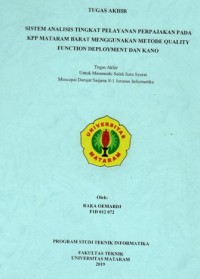
Tugas Akhir Informatika
SISTEM ANALISIS TINGKAT PELAYANAN PERPAJAKAN PADA KPP MATARAM BARAT MENGGUNAKAN METODE KANO DAN QUALITY FUNCTION DEPLOYMENT
Excellent service is an effort by KPP Mataram Barat to increase taxpayers’ willingness to fulfill their tax obligations. Nowadays, the current measuring system fails to assess service indicators level in detail. Therefore, an advanced system is needed to determine the tax services improvement direction and achieve the taxpayers’ expectations and perceptions of the current state of services. To run this system, taxpayers fill out questionnaires on the system and the results are calculated by quality function deployment (QFD) and Kano methods. The QFD method is used to calculate the taxpayers’ expectation value and perception on tax service indicators which are built into house of quality (HoQ) matrix, while the Kano Method is used to categorize and classify the influence level of tax service indicators on service improvement attributes. Based on black-box testing and mean opinion score (MOS), this system has been running as expected with a percentage value of 97,395%. Priority results are obtained with the first attribute the need for increased understanding of taxpayers for quality management with a percentage of 9,207%, the second attribute the need for improvement in fiscal services procedures with a percentage of 9,157% and the third attribute the need for increased quality control of service with a percentage of 9.112%.
Excellent service is an effort by KPP Mataram Barat to increase taxpayers’ willingness to fulfill their tax obligations. Nowadays, the current measuring system fails to assess service indicators level in detail. Therefore, an advanced system is needed to determine the tax services improvement direction and achieve the taxpayers’ expectations and perceptions of the current state of services. To run this system, taxpayers fill out questionnaires on the system and the results are calculated by quality function deployment (QFD) and Kano methods. The QFD method is used to calculate the taxpayers’ expectation value and perception on tax service indicators which are built into house of quality (HoQ) matrix, while the Kano Method is used to categorize and classify the influence level of tax service indicators on service improvement attributes. Based on black-box testing and mean opinion score (MOS), this system has been running as expected with a percentage value of 97,395%. Priority results are obtained with the first attribute the need for increased understanding of taxpayers for quality management with a percentage of 9,207%, the second attribute the need for improvement in fiscal services procedures with a percentage of 9,157% and the third attribute the need for increased quality control of service with a percentage of 9.112%.
Ketersediaan
| 2018194 | 336.200 959.Rak.s | Tersedia |
Informasi Detail
- Judul Seri
-
-
- No. Panggil
-
336.200 959.Rak.s
- Penerbit
- Universitas Mataram : Fakultas Teknik Unram., 2019
- Deskripsi Fisik
-
iv,52 Hlm, 21x29 cm
- Bahasa
-
Indonesia
- ISBN/ISSN
-
-
- Klasifikasi
-
336.200 959
- Tipe Isi
-
other
- Tipe Media
-
other
- Tipe Pembawa
-
-
- Edisi
-
Edisi 1 Jilid 1
- Subjek
- Info Detail Spesifik
-
-
- Pernyataan Tanggungjawab
-
Raka Oemardi
Versi lain/terkait
Tidak tersedia versi lain
Lampiran Berkas
Komentar
Anda harus login sebelum memberikan komentar
 Karya Umum
Karya Umum  Filsafat
Filsafat  Agama
Agama  Ilmu-ilmu Sosial
Ilmu-ilmu Sosial  Bahasa
Bahasa  Ilmu-ilmu Murni
Ilmu-ilmu Murni  Ilmu-ilmu Terapan
Ilmu-ilmu Terapan  Kesenian, Hiburan, dan Olahraga
Kesenian, Hiburan, dan Olahraga  Kesusastraan
Kesusastraan  Geografi dan Sejarah
Geografi dan Sejarah